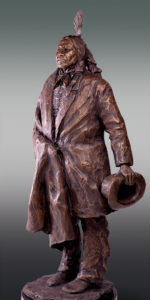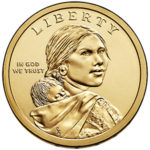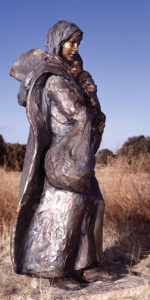Glenna Goodacre might have retired in 2016, but her legacy as one of the nation’s pre-eminent sculptors remains intact. The 80-year-old artist recently spoke with Wild West from her home in Santa Fe, N.M., reflecting on her career. That career includes the Sacagawea dollar, of course, but also the Vietnam Women’s Memorial in Washington, D.C., and the Irish Memorial in Philadelphia. She rendered a well-known sculpture of President Ronald Reagan (on display at the National Cowboy & Western Heritage Museum in Oklahoma City and the Ronald Reagan Presidential Library in Simi Valley, Calif.) and countless bronzes of American Indians, primarily from the Pueblo people of northern New Mexico.

Among Goodacre’s personal favorite works is a monumental bronze of Brulé Lakota Chief Spotted Tail, who visited Washington, D.C., several times as a peace chief before being shot and killed by fellow Brulé Crow Dog in 1881. She cast Spotted Tail Goes to Washington in 1999. “I loved Spotted Tail,” she says, “because he meant so much to so many people.”
A native of Lubbock, Texas, Goodacre enjoyed drawing from an early age and resolved to make art her life’s work after earning a blue ribbon at a local fair. When studying sculpture at Colorado College, however, she ran into an obstacle. “The professor didn’t like me, and I didn’t like him,” she explains, “so I got a D in sculpting. But I recovered and went to New York and the Art Students League.”
And Goodacre might have continued as a painter had she not approached Santa Fe gallery owner Forrest Fenn after molding a sculpture of a ballerina—Goodacre’s daughter, Jill, who in adulthood became a well-known model—in 1969 while living in Lubbock, Texas. Fenn was showing Goodacre’s paintings in a gallery there. Though he had no prior experience, the gallery owner managed on the fly to cast a bronze of Goodacre’s statue, and when Fenn opened a gallery in Santa Fe in 1972, he represented the artist. Goodacre’s career took off from there. In 1988 Fenn sold the gallery to Nedra Matteucci, whose gallery still sells Goodacre’s highly sought art on the secondary market.
Goodacre’s interest in Pueblo culture stems from summers spent with family at a cabin near Pecos, N.M., particularly when the family drove into Santa Fe and browsed the works of Indian artists on the plaza. “I thought all the Indians on the plaza were real live wild Indians,” she recalls. That fascination prompted her sculptures of the people themselves.
“I’m a reader, so I research everything I’m doing,” she explains. “But I’d go far to find live models.”

She’d likely still be at it, but Goodacre suffered a brain hemorrhage in 2007, which ultimately forced her retirement. She donated her sculpting tools, clay and equipment to the New Mexico School for the Arts, a four-year public high school in Santa Fe. “Physical inabilities cramp your style,” she says. Her work remains available at Nedra Matteucci Galleries in Santa Fe, among other places.
The Sacagawea dollar is the most public highlight of Goodacre’s career. She had enjoyed rendering bas-relief—a cross between sculpture and painting—but the process to create the coin was demanding. “Different techniques, different feelings,” she said. “I went back and forth, back and forth. I had in my mind what I wanted to say, but every time I went back, I had made the reliefs too high.” The perfectionist in her paid off when her design was accepted and the coin minted in 2000. The golden dollar remains available to collectors.

Goodacre takes pride in other sculptures, too, including Crossing the Prairie, Sacred Song and Waterbearers, which stands on the New Mexico State Capitol grounds. But her favorite is the Vietnam Women’s Memorial on the Washington Mall. Among her many honors are the James Earl Fraser Sculpture Award at the Prix de West exhibition at the National Cowboy & Western Heritage Museum and induction into the Cowgirl Hall of Fame in Fort Worth, Texas.
So, whatever happened to that professor who gave her a D in sculpture but hardly derailed her chosen career?
“He was fired the next year,” Goodacre replies with a grin. She got the last word, too. When invited to give the commencement address at Colorado College in 1994, the famed sculptor titled her speech, “Success Is the Greatest Revenge.” WW





